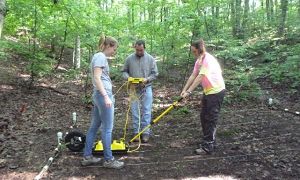Ground Penetrating Radar - Monitoring Soil Moisture
Grades 6 -
12
Geophysics
Activity
Educational Objectives
This activity explores methods for visualizing and understanding the relationship between plant features (biosphere), the development of subsurface water flow pathways (hydrosphere and lithosphere), and variations in soil moisture content through time. You will use data collected from the Shale Hills field site to accomplish the following objectives:
- Describe the relationship between GPR transmission-reflection delay times, wave speed of electromagnetic radiation, and soil depth. (HS-PS4-5)
- Interpret field data to infer the location of rocks, roots, and other point reflectors located in the subsoil. (HS-PS2-6)
- Compare time-lapse GPR field data with soil moisture measurements to describe the impact of surface rainfall on soil moisture changes at various depths. (HS-ESS2-5)
Audience
K-12
NGSS Crosscutting Concepts: Cause and Effect - Mechanism and Explanation
NGSS Science & Engineering Practices: Planning and Carrying Out Investigations | Obtaining, Evaluating, and Communicating Information
NGSS Disciplinary Core Ideas: PS2 - Motion and Stability: Forces and Interactions | PS4 - Waves and Their Applications in Technologies for Information Transfer | ESS2 - Earth’s Systems
Observatory: Shale Hills CZO
Author(s): Paul Longwell (2014 CZO RET)
Contact(s):
Funding: Financial support from NSF EAR #1263212: REU/RET Site: Collaborative Research: Introducing Critical Zone Observatory Science to Students and Teachers
Explore Further


